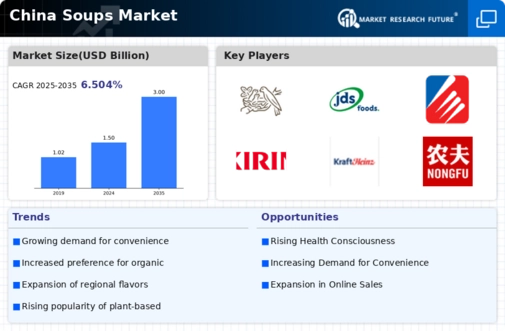Urbanization and Busy Lifestyles
Urbanization in China is significantly impacting the soups market, as more individuals move to cities and adopt fast-paced lifestyles. This demographic shift leads to an increased demand for convenient meal solutions, including ready-to-eat soups. Data shows that urban consumers are more likely to purchase packaged soups, with sales in urban areas accounting for over 60% of total soup sales. The need for quick meal options that do not compromise on taste or nutrition is driving innovation in the soups market. As urban living continues to rise, the market is expected to adapt, offering a wider variety of convenient soup products to meet consumer needs.
Rising Demand for Plant-Based Soups
The soups market in China is experiencing a notable shift towards plant-based options, driven by increasing health consciousness among consumers. As more individuals adopt vegetarian and vegan diets, the demand for plant-based soups is likely to rise. Recent data indicates that the plant-based food sector in China has grown by approximately 20% annually, reflecting a broader trend towards sustainable eating. This shift is influencing product development within the soups market, as manufacturers innovate to create flavorful and nutritious plant-based offerings. The growing awareness of the environmental impact of meat consumption further propels this trend, suggesting that the soups market will continue to expand in this direction.
Growing Interest in Functional Foods
The trend towards functional foods is gaining traction within the soups market in China. Consumers are increasingly seeking products that offer health benefits beyond basic nutrition, such as immune support and digestive health. Soups enriched with vitamins, minerals, and probiotics are becoming more popular, as they align with the health-oriented preferences of modern consumers. Recent surveys indicate that nearly 40% of Chinese consumers are willing to pay a premium for functional food products. This growing interest suggests that the soups market will likely see an influx of innovative products designed to cater to health-conscious consumers, thereby expanding its reach and appeal.
Influence of E-commerce on Soup Sales
The rise of e-commerce in China is transforming the soups market, providing consumers with unprecedented access to a variety of soup products. Online shopping platforms have become essential for soup manufacturers, allowing them to reach a broader audience and cater to diverse consumer preferences. Recent statistics reveal that online sales of packaged soups have surged by over 30% in the past year, indicating a shift in purchasing behavior. This trend suggests that the soups market will continue to evolve, with brands increasingly focusing on digital marketing strategies and online distribution channels to enhance visibility and sales.
Culinary Innovation and Flavor Exploration
Culinary innovation is a driving force in the soups market, as consumers in China become more adventurous in their flavor preferences. The demand for unique and exotic flavors is prompting manufacturers to experiment with new ingredients and recipes. Recent market analysis indicates that fusion soups, which blend traditional Chinese flavors with international cuisines, are gaining popularity. This trend reflects a broader cultural shift towards culinary exploration, suggesting that the soups market will continue to diversify. As consumers seek novel taste experiences, brands that prioritize innovation in flavor profiles are likely to thrive in this competitive landscape.





















Leave a Comment